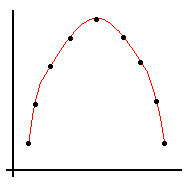Ans: A bivariate dataset that is univariate normal in any direction.
Ans: 5: x, y, SDx, SDy, and r.
Ans: m means + m sds + m(m-1)/2 pairwise correlations for a total of 2m + m(m-1)/2 = m2/2 + 3m/2 parameters.
Ans: A situation where the response curve is nonlinear as in the following image. The correlation is zero, but there is perfect causality.

Ans: It tells you the proportion of variation in the dependent variable that can be explained by x.
| x | y |
|---|---|
| 1 | 1 |
| 2 | 3 |
| 3 | 2 |
| 4 | 4 |
Here is a table of the calculations:
| x | y | zx | zy | zx zy |
|---|---|---|---|---|
| 1 | 1 | -1.161895 | -1.161895 | 1.35 |
| 2 | 3 | -0.387298 | 0.087298 | -0.15 |
| 3 | 2 | 0.387298 | -0.387298 | -0.15 |
| 4 | 4 | 1.161895 | -1.161895 | 1.35 |
The average of the products is (1.35 + (-0.15) + (-0.15) + 1.35) / 4 = 0.60. Multiply this by the correction factor n / (n-1) to obtain the correlation:
-
r = n / (n-1) * 0.6 = 4 / 3 * 0.6 = 0.8.